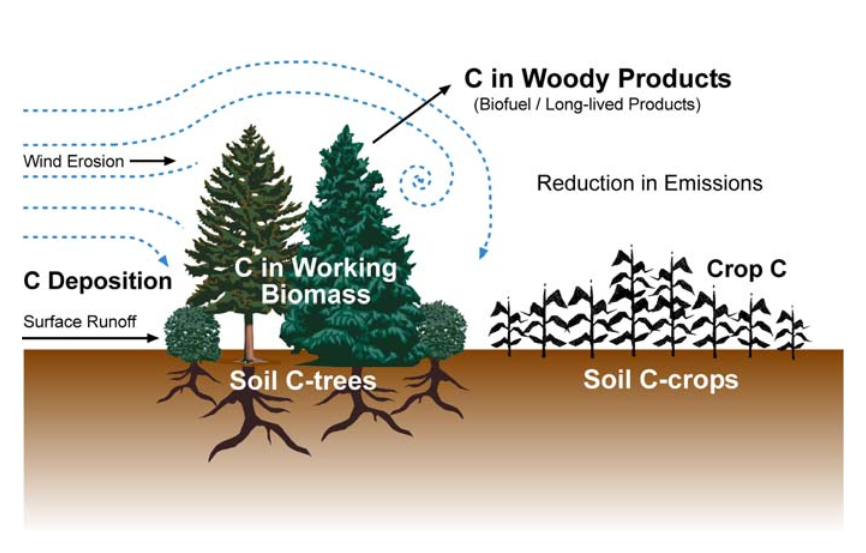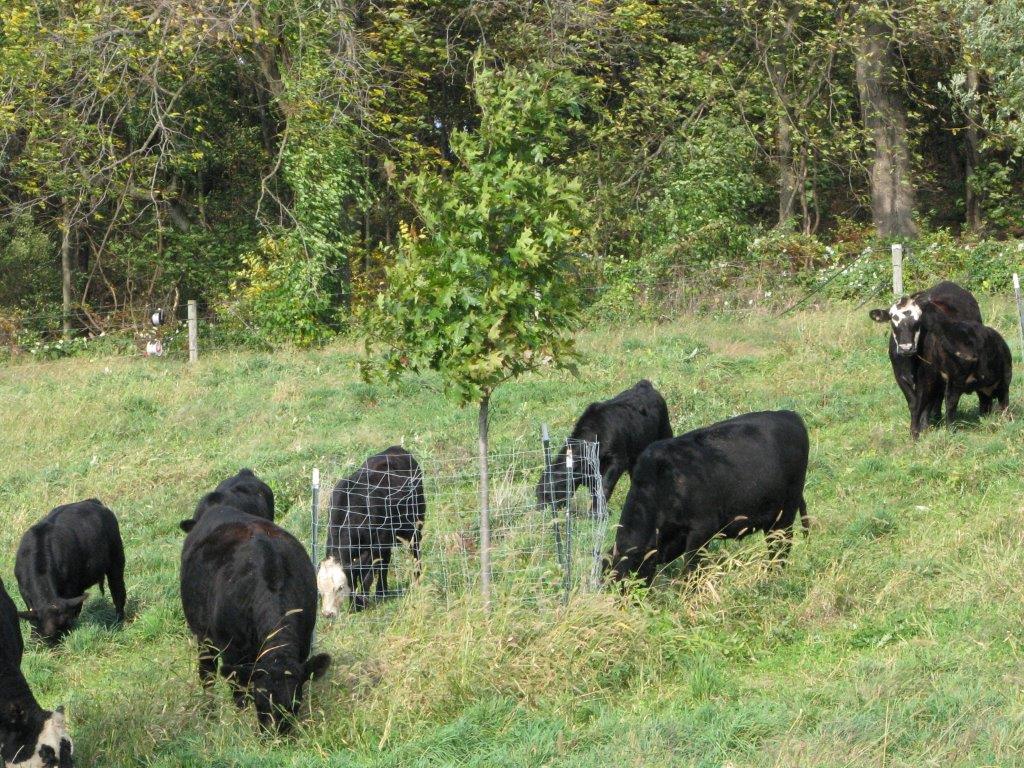Forests store or sequester a lot of carbon. Nationwide, USDA Greenhouse Gas Inventories indicate that forests, urban trees, and harvested wood account for the majority of natural sinks of carbon dioxide (USDA OCE 2016).
However, trees outside of forests, including those planted in agroforestry practices, also play an important role in carbon sequestration and reducing greenhouse gas emissions. Agroforestry is the intentional integration of trees and shrubs into crop and animal farming systems to create environmental, economic, and social benefits. In the Northeast, as in other temperate regions, the most common agroforestry practices are riparian forest buffers, windbreaks, silvopasture, alley cropping, and forest farming. Most agroforestry practices are designed to be multifunctional. Here, this means that they can be designed to sequester carbon while also benefiting the farmer or forest landowner in other ways.
Agroforestry contributes to climate change mitigation in three ways.
(1) Sequestering carbon in biomass and soils, (2) reducing greenhouse gas emissions, and (3) avoiding emissions through reduced fossil fuel and energy usage on farms. For a windbreak (Figure 1), the growing trees store carbon directly in their biomass and in the soil. At the same time, the system releases fewer greenhouse gases, like nitrous oxide, because the trees take up extra nutrients and also because less area is fertilized. Finally, less fossil fuel and energy are used in the agricultural operation because some of the field is no longer cultivated. All of these components contribute to the climate change mitigation that can come from adding agroforestry practices to northeastern agricultural and forested landscapes.

Figure 1: Major carbon sinks and sources that can be affected by a field windbreak. Image credit: Schoenberger 2008.
At the same time farmers mitigate climate change through agroforestry practices, they can also get other benefits.
These benefits include increased yields, reduced risks, improved pollinator and wildlife habitats, or increased capacity to adapt to climate change. This makes agroforestry more appealing to farmers who are working towards multiple outcomes. Agroforestry practices can also work in cooperation with other carbon sequestration practices and make them more risk resilient. For example, windbreaks and cover cropping can work together. The reduced wind speed may make cover crop establishment easier in challenging conditions. Agroforestry can sequester carbon while leaving most of the field in agricultural production, instead of converting it to forests or other land uses. This is especially true for agroforestry practices that take place at the edge of fields, such as windbreaks and riparian forest buffers. Even if only a small percentage of farms add agroforestry practices, the potential carbon sequestration can be significant.
Figure 2: Trees planted into pasture at Dickinson College Farm’s silvopasture site in Pennsylvania. Photo credit: Dan Dostie, NRCS.
Specific design and management approaches can increase or decrease the climate change mitigation potential of agroforestry practices.
Tree species can be selected for their carbon sequestration characteristics. When planning riparian forest buffers, the buffer zones closest to fields can be designed to be harvested, by selecting species that can be used on-farm or sold. Harvesting can help remove nitrogen from the site that is captured in the harvested woody materials and help maintain more actively growing plant materials, which increases future nutrient uptake.
Silvopasture systems that add trees to pastures may have the greatest potential among the agroforestry practices to mitigate climate change. (See this virtual field tour of Dickinson College Farm’s silvopasture, where trees were added to pasture in Pennsylvania.) As before, carbon is sequestered in the trees that are planted into the pasture and in the soils. Silvopasture may also reduce methane emissions, an important contributor to greenhouse gas emissions. Silvopasture management can reduce methane emissions by using a grazing strategy of moving cattle in a rotational stocking system. Another factor leading to lower methane is more digestible feed and greater overall gain from feed efficiency due to shade-induced microclimate changes.
In the Northeast and across the country, agroforestry practices provide key ways for farmers and other land managers to contribute to agricultural climate change mitigation activities while also providing other production and conservation benefits to the landowner.
For more information:
- Schoeneberger, Michele; Domke, Grant. 2017. Chapter 3: Greenhouse gas mitigation and accounting. In: Schoeneberger, Michele M.; Bentrup, Gary; Patel-Weynand, Toral, eds. 2017. Agroforestry: Enhancing resiliency in U.S. agricultural landscapes under changing conditions. Gen. Tech. Report WO-96. Washington, DC: U.S. Department of Agriculture, Forest Service. 43-62.
- Bentrup, Gary; Cernusca, Ina; Gold, Michael. 2018.Supporting U.S. agricultural landscapes under changing conditions with agroforestry: An annotated bibliographyBibliographies and Literature of Agriculture 137. Washington, DC: U.S. Department of Agriculture Forest Service. 63 p.





